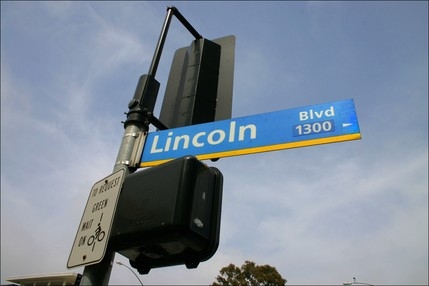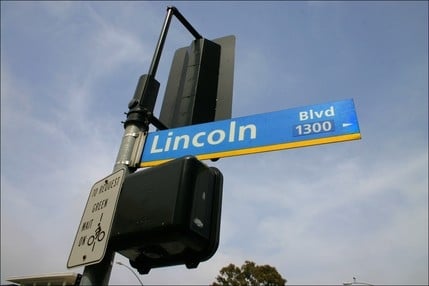
CITY HALL — Approximately four score and seven years ago, Santa Monica city officials made an executive decision to change what was once Eighth Street to Lincoln Boulevard.
Now, a new generation is considering changing it back as part of a range of proposals meant to reinvigorate the lagging street and set down rules for future development in Downtown.
Planning staff revealed early thoughts on what will be a vision to guide the growth of one-half square mile of Downtown to a joint meeting of the Planning Commission and Architectural Review Board on Wednesday.
The document, called the Downtown Specific Plan, is set to be finished by 2013, and will fill in the details of the design created by the Land Use and Circulation Element, or LUCE, which was adopted by the City Council in 2010.
The report presented Wednesday details thoughts for Ocean Avenue and Wilshire Boulevard, but a good deal of the early work focuses on Lincoln, which staff and consultants want to transform into a “gracious mixed-use boulevard” that provides an entrance into the city.
Lincoln Boulevard’s possible re-christening as Eighth Street would be part of an aggressive re-branding program to change the thoroughfare’s reputation from “stinkin’ Lincoln,” as one member of the Architectural Review Board put it, to something a little more urbane.
The name “Lincoln” may have outlived its usefulness, said consultant Neal Payton, of Torti Gallas and Partners.
“North of the 10 (Freeway), Lincoln (Boulevard) serves a different form and function,” Payton said. “It’s not perceived as one of Los Angeles’ great streets.”
Early plans focus on creating a 20-foot margin between the curb on Lincoln and the front of buildings that serve it.
The space can then be used for decoration, benches, lighting, bike racks and trash receptacles that would make Lincoln Boulevard an attractive place for pedestrians rather than a necessary trek for motorists.
Although the details have not yet been worked out, simple alterations could make Lincoln a destination street, Payton said.
“Who knows yet?” he said. “It should be something that says ‘wow,’ this is a street they really care about. A big deal street. A center of town kind of street.”
The changes would be welcome for pedestrians, said Gerda Newbold, chair of the Planning Commission.
“If Lincoln becomes more walkable and pleasant, people might actually use it on foot,” she said.
The early plan also looks at potentially dramatic changes for Wilshire Boulevard, including encroaching on lanes of traffic west of Fourth Street.
Wilshire Boulevard really doesn’t need the space past that point, Payton said Thursday.
“The design of Wilshire Boulevard in terms of lane width is consistent all through Santa Monica,” Payton said. “At a certain point, the traffic does begin to taper off. Do you really need all of those lanes?”
Creating wider walkways and more vibrant intersections along Wilshire would help pull people to the north end of the Promenade, which lacks the focal point and foot traffic of its southern end.
Plans for Ocean Avenue revolve around the massive amount of changes already in progress, including the Palisades Garden Walk and The Village mixed-use development that will add another 600 to 700 residents to the area.
Ensuring smooth circulation and attractive places for pedestrians to enjoy are critical to the area’s success, Payton said.
Planners are still in the early stages of ironing out the Downtown Specific Plan, one of several massive planning efforts taking place in Santa Monica. It will be another year until it’s completed and ready for final approval.
In the meantime, planners and consultants will be digging into the difficult question of community benefits, height and massing of development and design standards to build into the plan.
Even after it’s approved, it will take years before residents see the full impact of the plan because most everything is based on private developers creating projects impacted by the new requirements, Payton said.
“The build-out will occur as the build-out occurs since so much of this is contingent on private sector development,” Payton said. “We’re not saying this is all going to happen at once. We’re saying that if development occurs, shouldn’t it occur in the way we want it to? Shouldn’t we be in front of that so we get the city we want?”
ashley@www.smdp.com








